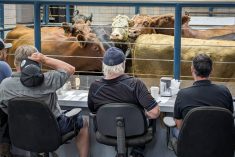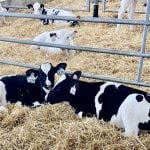Western Canadian feeder cattle prices were steady for yearlings, while lighter-weight cattle appeared to be slightly softer this week. Fed cattle were under pressure due to weaker wholesale beef prices.
Retail movement for higher-end cuts appears to have slowed in January while movement for ground beef and lower-quality steaks has actually improved. Feedlot margins are once again in red ink by nearly $50 per head, which has stemmed buying interest for replacement cattle.
Auction markets reported a lighter run of feeders with extremely cold temperatures noted in Manitoba and Saskatchewan. South of Calgary, mixed steers weighing 500 to 600 pounds averaged $155 per hundredweight (cwt); steers weighing 700 to 800 lbs. sold for an average of $133/cwt. In central Saskatchewan, a mixed group of exotic steers averaging 550 lbs. sold for $149/cwt; heavier steers weighing 700 to 800 lbs. sold in the range of $125-$138/cwt. Alberta packers were buying slaughter cattle from $114 to $116/cwt.
Read Also

U.S. livestock: Cattle fall back, hogs continue slide
Chicago cattle futures fell back on Tuesday. Hogs continued to slide. Most-active December live cattle futures closed at 227.775 cents…
Cattle merchants are expecting larger volumes of backgrounded cattle to come on the market in February. The fed market will likely remain stagnant and with firm barley prices, the feeder market will likely hold value. I’m expecting the fed market to increase in March, which should provide underlying support to feeders.
There is a fair amount of uncertainty in the feedgrains complex given the tight corn and barley supplies. Cattle are being fed to heavier weights but we have seen significant equity erosion in the feedlot sector over the past four months. Feeder cattle have potential to move higher in March-April, but the upside will be limited given the current environment.
I believe there is opportunity for cow-calf producers buying bred heifers or cow-calf pairs. I’m fairly optimistic for the fall period and next spring as the economy improves and consumer spending increases due to larger disposable income. Analysts are expecting a sharp year-over-year decline in fourth-quarter beef production.
— Jerry Klassen is a commodity market analyst in Winnipeg and maintains an interest in the family feedlot in southern Alberta. He writes an in-depth biweekly commentary, Canadian Feedlot and Cattle Market Analysis, for feedlot operators in Canada. He can be reached by email at [email protected] for questions or comments.















